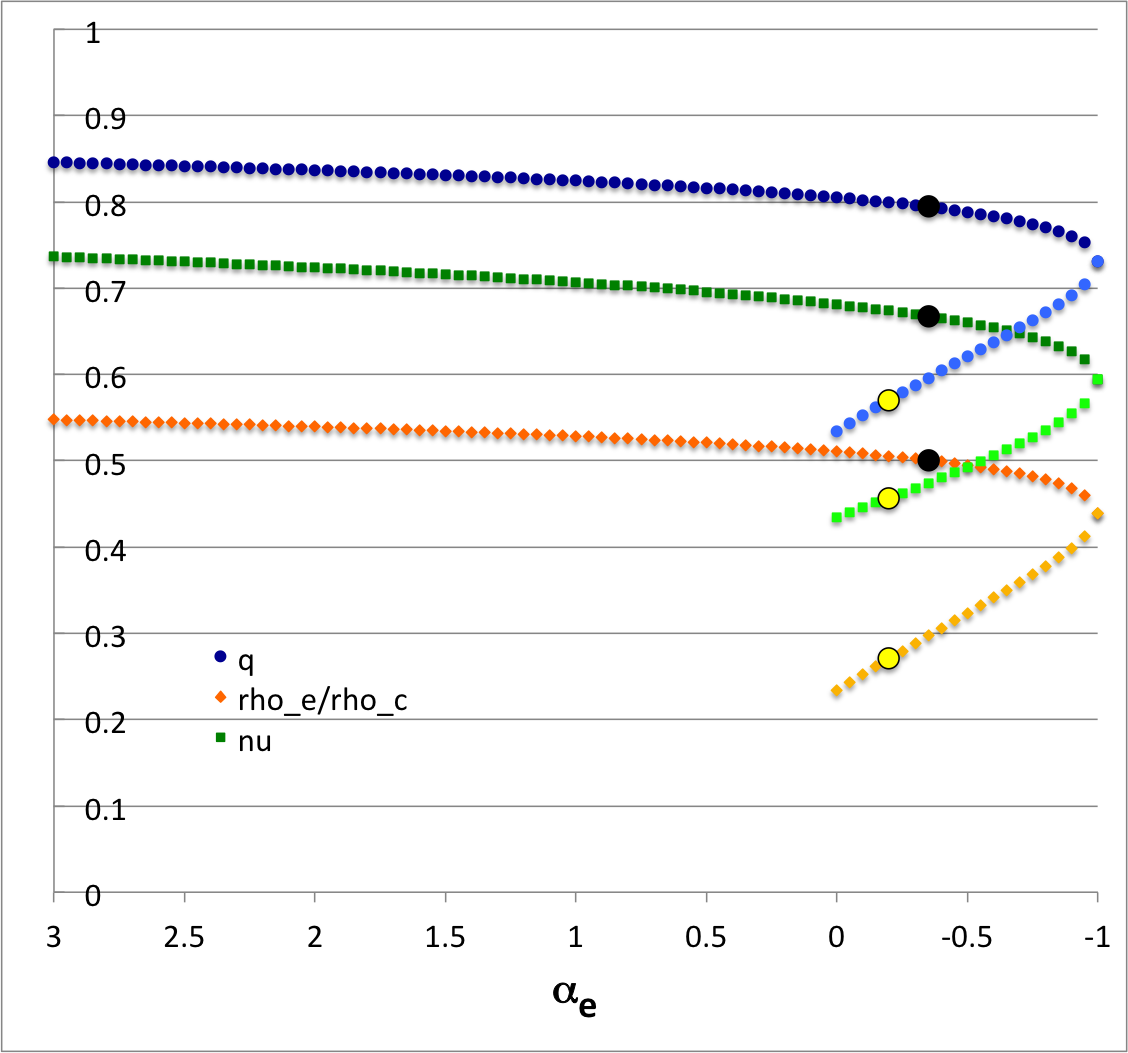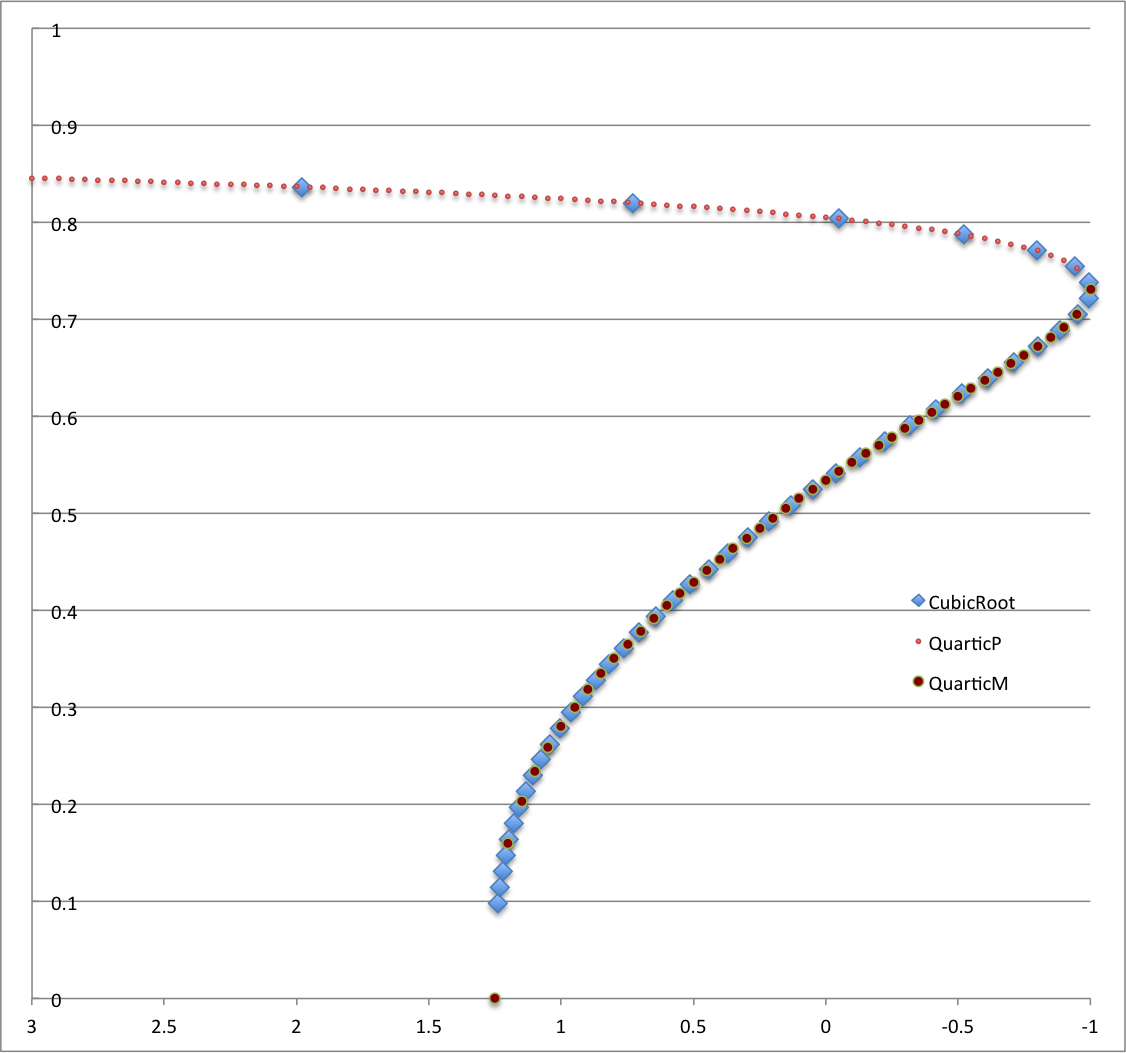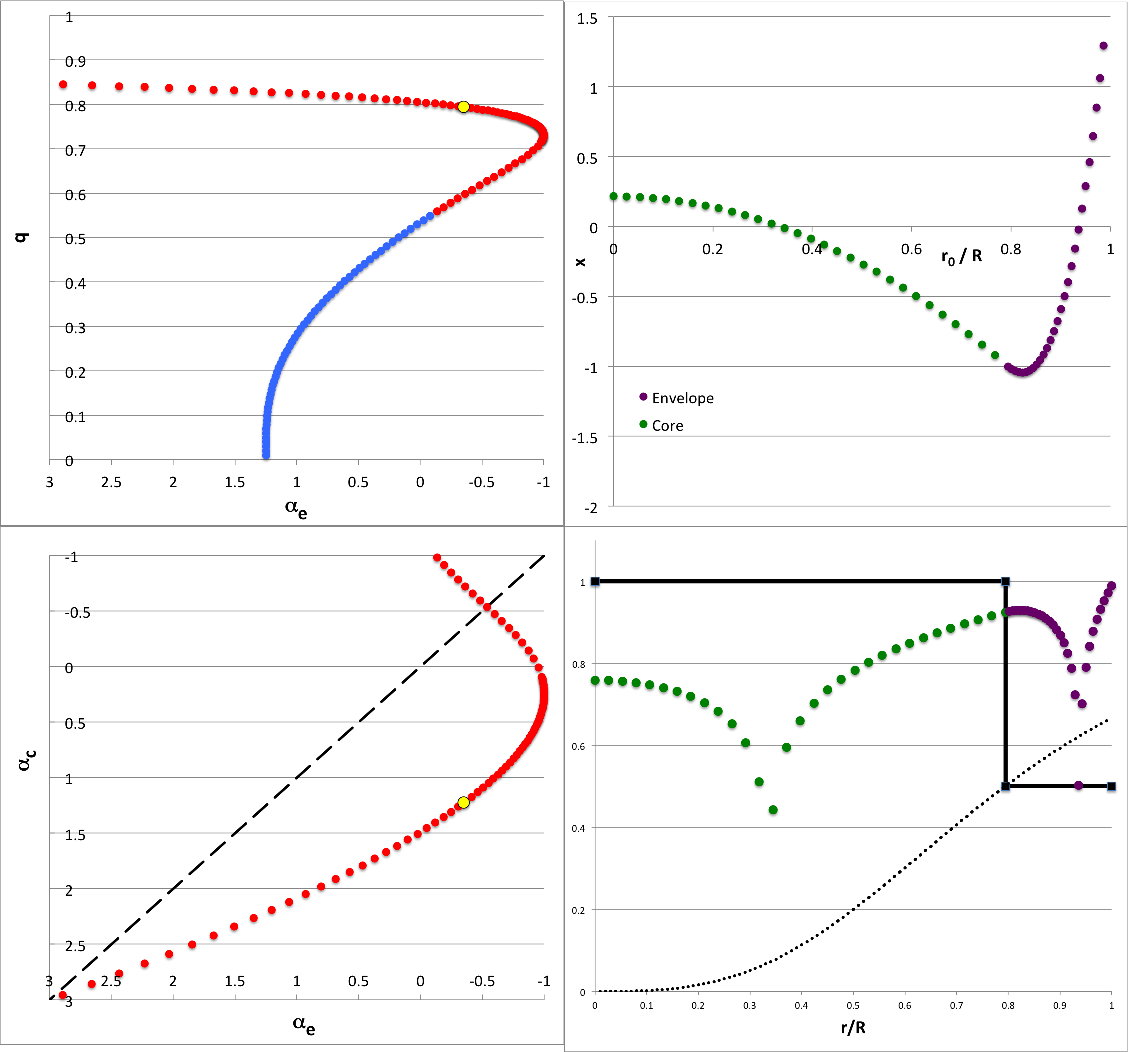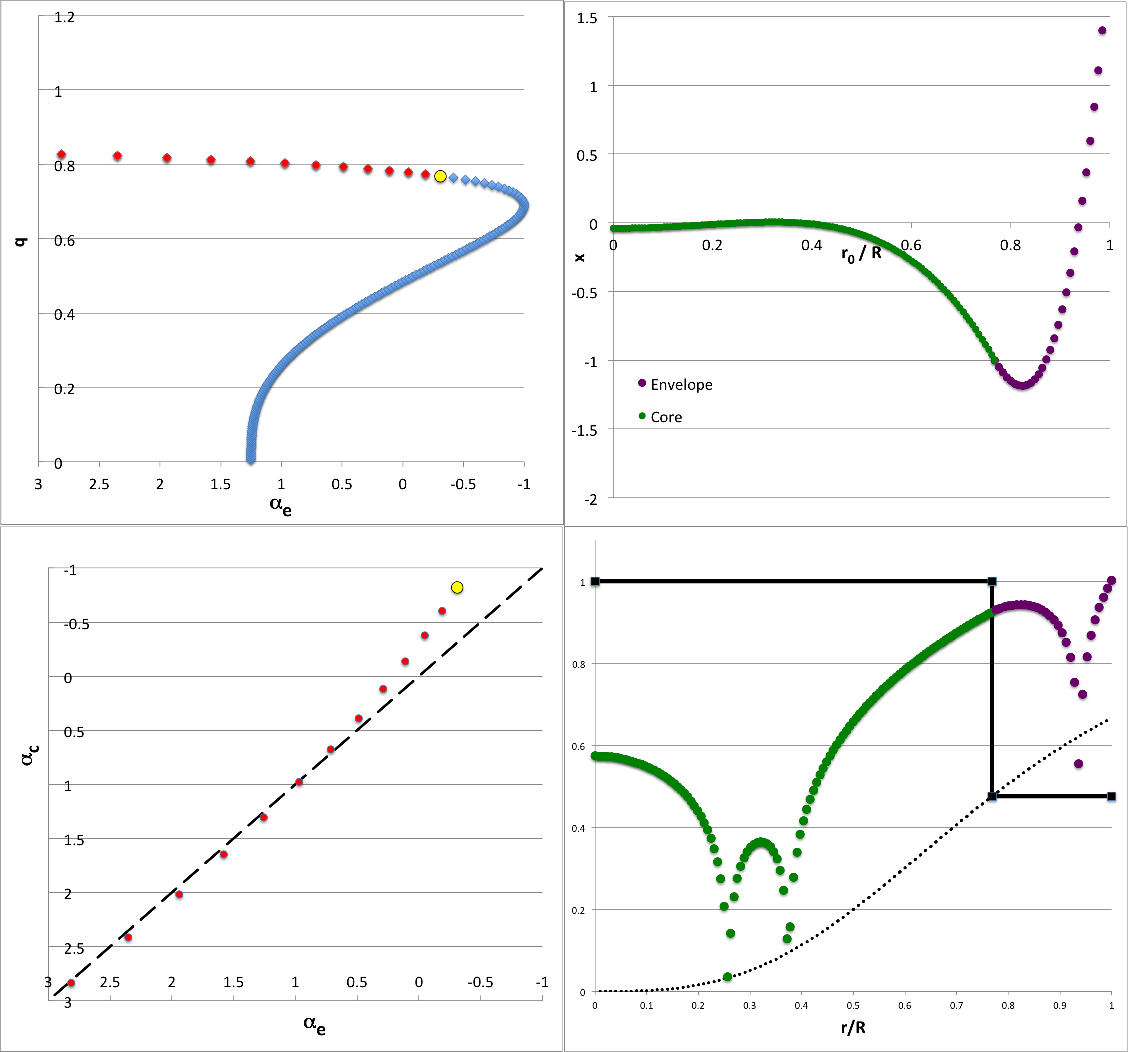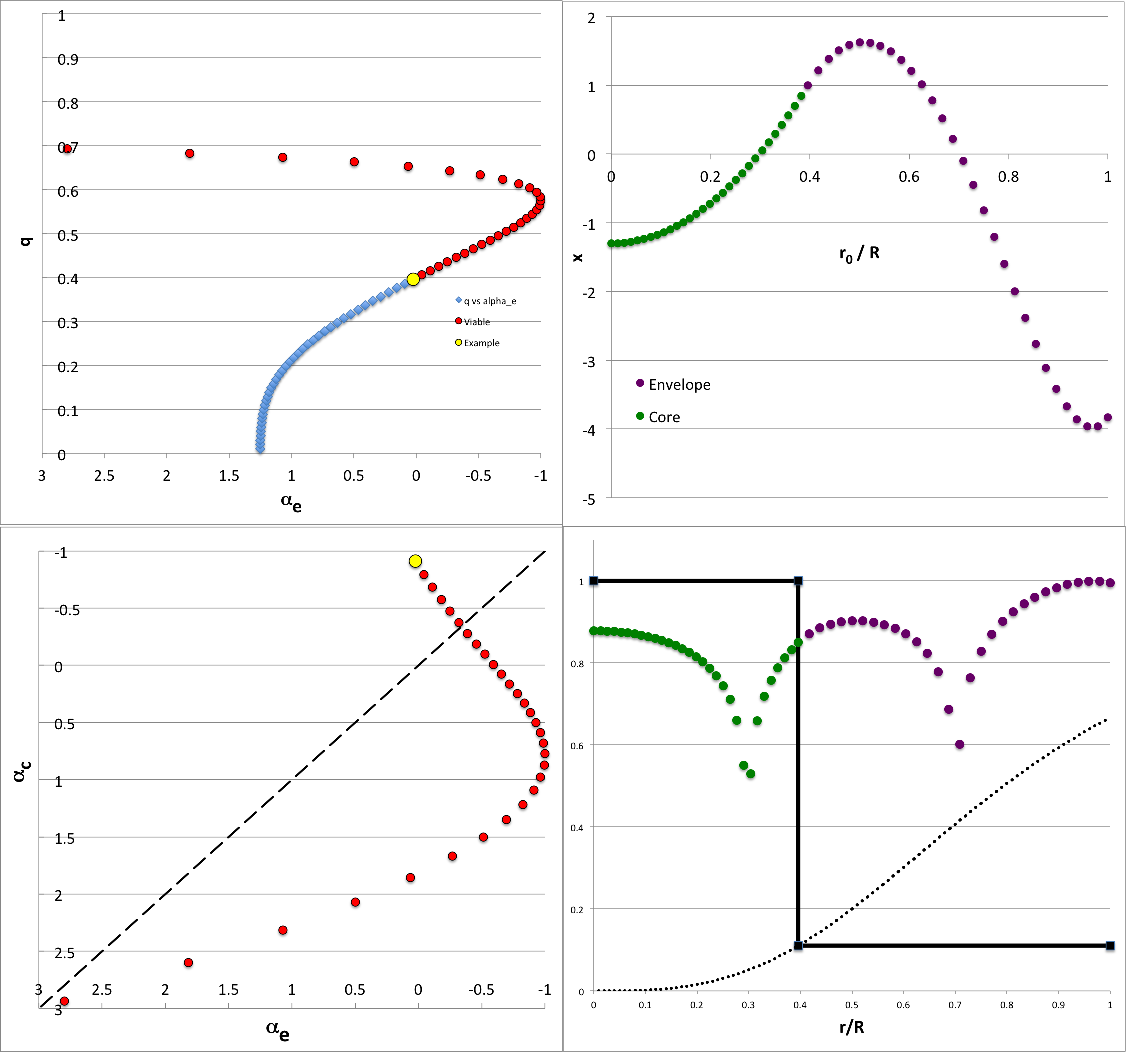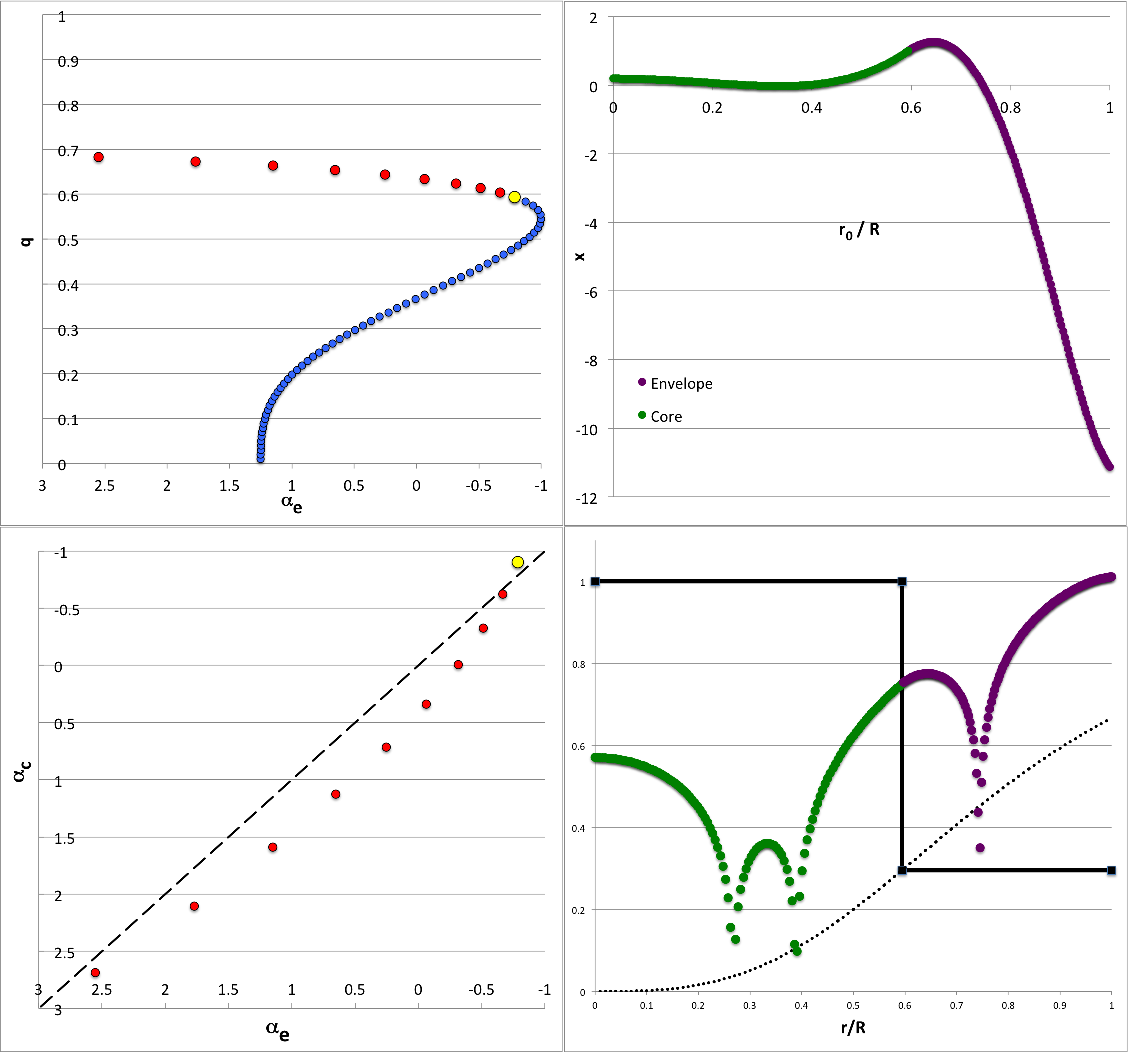User:Tohline/Appendix/Ramblings/Additional Analytically Specified Eigenvectors for Zero-Zero Bipolytropes
Searching for Additional Eigenvectors of Zero-Zero Bipolytropes
This chapter is an extension of two accompanying discussions: The original discovery and detailed derivation; and the more readable, summary.

|
|---|
| | Tiled Menu | Tables of Content | Banner Video | Tohline Home Page | |
In our accompanying summary, we have demonstrated how analytically specified eigenvectors can be constructed for the mode labeled, <math>~(\ell, j) = (2,1)</math>. This was done by specifying <math>~\gamma_e</math>, then solving a quartic equation for <math>~q</math>. Shortly after completing this summary chapter, we noticed that an alternate approach may be to specify <math>~q</math>, then solve for <math>~\gamma_e</math>; and this path may be simpler because it may only involve solution of a quadratic equation. (Actually, we later have realized that the relevant equation is cubic, rather than quadratic. This is nevertheless simpler than the quartic equation.) If this proves to be the case, then it may also be possible to analytically construct eigenvectors of additional modes. Let's see.
Seek Alternate Solution to Mode21 <math>~(\ell,j) = (2,1)</math>
Setup21
According to STEP 4 in our accompanying summary discussion, we need to solve the following "derivative matching" expression:
|
<math>~\frac{14(1+2q^3)^2}{7(1+2q^3)^2 - 5}</math> |
<math>~=</math> |
<math>~ \frac{c_0 + (c_0 + 3)A_{21}q^3 + (c_0 + 6)A_{21}B_{21} q^6}{1 + A_{21}q^3 + A_{21}B_{21}q^6} \, , </math> |
where, recognizing that, <math>~\alpha_e = c_0(c_0+2) \, ,</math>
|
<math>~A_{21}</math> |
<math>~\equiv</math> |
<math>~\biggl[ \frac{c_0(c_0+5) - (c_0 + 6)(c_0 + 11)}{(c_0 + 3)(c_0+5) - \alpha_e}\biggr] </math> |
|
|
<math>~=</math> |
<math>~\biggl[ \frac{c_0^2 + 5c_0 - (c_0^2 + 17c_0 + 66)}{(c_0^2 + 8c_0 + 15) - (c_0^2+2c_0)}\biggr] </math> |
|
|
<math>~=</math> |
<math>~-\biggl( \frac{ 4c_0 + 22}{2c_0 + 5}\biggr) \, ,</math> |
|
<math>~B_{21}</math> |
<math>~\equiv</math> |
<math>~\biggl[ \frac{(c_0+3)(c_0+8) - (c_0 + 6)(c_0 + 11)}{(c_0 + 6)(c_0+8) - \alpha_e}\biggr] </math> |
|
|
<math>~=</math> |
<math>~\biggl[ \frac{(c_0^2 +11c_0 + 24) - (c_0^2 + 17c_0 + 66)}{(c_0^2+14c_0+48) - (c_0^2 + 2c_0)}\biggr] </math> |
|
|
<math>~=</math> |
<math>~-\biggl( \frac{c_0 + 7 }{2c_0+8}\biggr) \, . </math> |
Here, we assume that <math>~\Chi \equiv q^3</math> is specified and seek the corresponding value of <math>~c_0</math>. Given that the LHS of this matching relation is known once <math>~\Chi</math> has been specified, in order to simplify notation we will also define,
|
<math>~Q</math> |
<math>~\equiv</math> |
<math>~\frac{14(1+2\Chi)^2}{7(1+2\Chi)^2 - 5} \, .</math> |
Then the matching relation becomes,
|
<math>~Q</math> |
<math>~=</math> |
<math>~ \frac{c_0 + (c_0 + 3)A_{21}\Chi + (c_0 + 6)A_{21}B_{21} \Chi^2}{1 + A_{21}\Chi + A_{21}B_{21}\Chi^2} </math> |
|
<math>~\Rightarrow~~~ 0</math> |
<math>~=</math> |
<math>~[c_0 + (c_0 + 3)A_{21}\Chi + (c_0 + 6)A_{21}B_{21} \Chi^2 ] - Q[1 + A_{21}\Chi + A_{21}B_{21}\Chi^2 ] </math> |
|
|
<math>~=</math> |
<math>~\biggl[c_0 - (c_0 + 3)\biggl( \frac{ 4c_0 + 22}{2c_0 + 5}\biggr)\Chi + (c_0 + 6)\biggl( \frac{ 4c_0 + 22}{2c_0 + 5}\biggr)\biggl( \frac{c_0 + 7 }{2c_0+8}\biggr) \Chi^2 \biggr] - Q\biggl[1 - \biggl( \frac{ 4c_0 + 22}{2c_0 + 5}\biggr)\Chi + \biggl( \frac{ 4c_0 + 22}{2c_0 + 5}\biggr)\biggl( \frac{c_0 + 7 }{2c_0+8}\biggr)\Chi^2 \biggr] </math> |
|
|
<math>~=</math> |
<math>~\biggl[c_0(2c_0+5)(2c_0+8) - (c_0 + 3)(2c_0+8)( 4c_0 + 22)\Chi + (c_0 + 6)( 4c_0 + 22)(c_0 + 7 ) \Chi^2 \biggr] </math> |
|
|
|
<math>~ - Q\biggl[(2c_0+5)(2c_0+8) - (2c_0+8)( 4c_0 + 22)\Chi + ( 4c_0 + 22)( c_0 + 7 )\Chi^2 \biggr] </math> |
|
|
<math>~=</math> |
<math>~\biggl\{c_0(4c_0^2 + 26c_0 + 40) + ( 4c_0 + 22)\Chi [(c_0^2 + 13c_0 + 42 ) \Chi- (2c_0^2 +14c_0 +24)] \biggr\} </math> |
|
|
|
<math>~ - Q\biggl\{ (4c_0^2 + 26c_0 + 40) + ( 4c_0 + 22)\Chi [c_0(\Chi-2) + (7\Chi-8) ] \biggr\} </math> |
|
|
<math>~=</math> |
<math>~4c_0^3 +[ 26 - 4Q]c_0^2 + [40 - 26Q]c_0 - 40Q </math> |
|
|
|
<math>~ + ( 4c_0 + 22)\Chi \biggl\{ [\Chi - 2]c_0^2 + [13\Chi -14 -Q (\Chi-2) ]c_0 + [42\Chi -Q (7\Chi-8) -24] \biggr\} </math> |
|
|
<math>~=</math> |
<math>~4c_0^3 +[ 26 - 4Q]c_0^2 + [40 - 26Q]c_0 - 40Q </math> |
|
|
|
<math>~ + 4\Chi[\Chi - 2]c_0^3 + 4\Chi[13\Chi -14 -Q (\Chi-2) ]c_0^2 + 4\Chi[42\Chi -Q (7\Chi-8) -24]c_0 </math> |
|
|
|
<math>~ + 22\Chi[\Chi - 2]c_0^2 + 22\Chi[13\Chi -14 -Q (\Chi-2) ]c_0 + 22\Chi[42\Chi -Q (7\Chi-8) -24] \, . </math> |
Solve Cubic Equation
Here we draw from a separate discussion of solutions to a cubic equation.
|
Using <math>~y</math> in place of <math>~c_0</math>, this "derivative matching" relation can be written in the form of a standard cubic equation. Specifically,
where,
As is well known and documented — see, for example Wolfram MathWorld or Wikipedia's discussion of the topic — the roots of any cubic equation can be determined analytically. In order to evaluate the root(s) of our particular cubic equation, we have drawn from the utilitarian online summary provided by Eric Schechter at Vanderbilt University. For a cubic equation of the general form, <math>~ay^3 + by^2 + cy + d = 0 \, ,</math> a real root is given by the expression, <math>~ y = p + \{z + [z^2 + (r-p^2)^3]^{1/2}\}^{1/3} + \{z - [z^2 + (r-p^2)^3]^{1/2}\}^{1/3} \, ,</math> where, <math>~p \equiv -\frac{b}{3a} \, ,</math> <math>~z \equiv \biggl[p^3 + \frac{bc-3ad}{6a^2} \biggr] \, ,</math> and <math>~r=\frac{c}{3a} \, .</math> (There is also a pair of imaginary roots, but they are irrelevant in the context of our overarching astrophysical discussion.) |
Upon evaluation, we have found that the expression inside of the square root is negative over the region of parameter space that is of most physical interest. Hence, we need to call upon a separate discussion in which the cube root of complex numbers was discussed.
|
We'll shift to Wolfram's notation; specifically,
Then, after defining, <math>~D \equiv Q^3 + R^2 = z^2 + (r-p^2)^3 \, ;</math> <math>~S^3 \equiv R+ \sqrt{D} \, ;</math> and <math>~T^3 \equiv R- \sqrt{D} \, ;</math> Wolfram states that the three roots of the cubic equation are (the first one being identical to the "real" root identified above),
Now, whenever <math>~D</math> is intrinsically negative, we need to treat both <math>~S^3</math> and <math>~T^3</math> as complex numbers. If we define,
then we can write,
As is explained in this online resource, both <math>~S</math> and <math>~T</math> must formally submit to three separate roots tagged by the integer index, <math>~(j=0,1,2)</math>. Working only with the <math>~j=0</math> root for both, we find that the above expressions for the three roots of our cubic equation become,
|
We have deduced empirically that <math>~y_3</math> is the root that is physically relevant in our case. That is to say, for a given <math>~0 < q < 1</math>,
<math>~c_0 = p - \mathfrak{r}^{1 / 3} \biggl[ \cos\biggl(\frac{\theta}{3}\biggr) - \sqrt{3} \sin\biggl(\frac{\theta}{3}\biggr) \biggr] \, .</math>
The light-blue diamonds in the right-hand panel of Figure 1 trace this <math>~c_0(q)</math> function, which is a solution to the above cubic equation. In the left-hand panel, we re-display a plot that has been discussed in an accompanying chapter. It contains a plot (blue markers) of the same function, but this time it is <math>~q(c_0)</math>, as determined from the root of a quartic equation. In order to illustrate more clearly that the two curves are the same, we have plotted the quartic solution on top of the cubic solution in the right-hand panel. The <math>~q(\alpha_e)</math> curve in the right-hand panel extends to smaller values of <math>~q</math> than does the corresponding curve in the left-hand panel. The curve on the left has been purposely truncated because, in the context of its original presentation, lower values of q would be associated with unrealistic values of the adiabatic exponent of the core.
Try Mode22 <math>~(\ell,j) = (2,2)</math>
In this case we need to replace the core eigenfunction segment that was specified in STEP 3 in our separate discussion of mode <math>~(\ell,j) = (2,1)</math> with the following:
|
<math>~x_{j=2} |_\mathrm{core}</math> |
<math>~=</math> |
<math>~ \frac{35 - 126 (1+2q^3)^2 \xi^2 + 99 (1+2q^3)^4 \xi^4 }{35 - 126 (1+2q^3)^2 + 99 (1+2q^3)^4 } \, .</math> |
So, following the procedure outlined in STEP 4 of our separate discussion, the requirement that the first derivatives match at the interface becomes,
|
<math>~\frac{ - 252 (1+2q^3)^2 + 396 (1+2q^3)^4 }{35 - 126 (1+2q^3)^2 + 99 (1+2q^3)^4 }</math> |
<math>~=</math> |
<math>~ \frac{c_0 + (c_0 + 3)A_{21}q^3 + (c_0 + 6)A_{21}B_{21} q^6}{1 + A_{21}q^3 + A_{21}B_{21}q^6} \, . </math> |
So, as described above, in order to determine <math>~c_0</math> for any specified value of <math>~q</math> — or, equivalently, <math>~\Chi \equiv q^3</math> — we simply need to replace <math>~Q_{21}</math> with <math>~Q_{22}</math> in the definition of the coefficient of each term in the cubic expression, where,
|
<math>~Q_{22}</math> |
<math>~\equiv</math> |
<math>~ \frac{ - 252 (1+2\Chi)^2 + 396 (1+2\Chi)^4 }{35 - 126 (1+2\Chi)^2 + 99 (1+2\Chi)^4 } \, . </math> |
| Figure 2: Results for mode <math>~(\ell,j) = (2,2)</math> | ||
| <math>~q</math> | <math>~0.768375</math> | |
| <math>~c_0</math> | <math>~-0.16913291</math> | |
| <math>~\gamma_e</math> | <math>~1.208583401</math> | |
| <math>~\alpha_e</math> | <math>~-0.30965989</math> | |
| <math>~n_e</math> | <math>~4.7942454</math> | |
| <math>~\nu</math> | <math>~0.6357658</math> | |
| <math>~\rho_e/\rho_c</math> | <math>~0.4756979</math> | |
| <math>~\gamma_c</math> | <math>~1.0464786</math> | |
| <math>~\alpha_c</math> | <math>~-0.822343</math> | |
Finally, as explained in our summary discussion, in order for the two (dimensional) eigenfrequencies to match, the adiabatic exponent for the core must be,
|
<math>~ \gamma_c </math> |
<math>~=</math> |
<math>~\frac{1}{[ 6 + 2j(2j+5)] } \biggl\{ 8 + \gamma_e \biggl[2\alpha_e + (c_0 + 3\ell)(c_0 + 3\ell +5) \biggr]\frac{\rho_e}{\rho_c} \biggr\} \, . </math> |
Try Mode31 <math>~(\ell,j) = (3,1)</math>
Setup31
In this case we need to replace the envelope eigenfunction segment that was specified in STEP 2 in our separate discussion of mode <math>~(\ell,j) = (2,1)</math> with the following: For the case of <math>~\ell=2</math>, this means that, throughout the envelope, the eigenfunction is,
|
<math>~x_{\ell=3} |_\mathrm{env}</math> |
<math>~=</math> |
<math>~ \xi^{c_0}\biggl[ \frac{ 1 + q^3 A_{31} \xi^{3} + q^6 A_{31}B_{31}\xi^{6} + q^9 A_{31}B_{31}C_{31}\xi^{9} }{ 1 + q^3 A_{31} + q^6 A_{31}B_{31} + q^9 A_{31}B_{31}C_{31} }\biggr] \, , </math> |
where, the values of the newly introduced coefficients,
|
<math>~A_{31}</math> |
<math>~\equiv</math> |
<math>~\biggl[ \frac{c_0(c_0+5) - (c_0 + 9)(c_0 + 14)}{(c_0 + 3)(c_0+5) - \alpha_e}\biggr] </math> |
|
|
<math>~=</math> |
<math>~\biggl[ \frac{c_0^2 + 5c_0 - (c_0^2 + 23c_0 + 126)}{(c_0^2 + 8c_0 + 15) - (c_0^2 + 2c_0)}\biggr] </math> |
|
|
<math>~=</math> |
<math>~\frac{- 6(c_0 + 7)}{2c_0 + 5 } \, ,</math> |
|
<math>~B_{31}</math> |
<math>~\equiv</math> |
<math>~\biggl[ \frac{(c_0+3)(c_0+8) - (c_0 + 9)(c_0 + 14)}{(c_0 + 6)(c_0+8) - \alpha_e}\biggr] </math> |
|
|
<math>~=</math> |
<math>~\biggl[ \frac{(c_0^2 + 11c_0 + 24) - (c_0^2 + 23c_0 + 126)}{(c_0^2 + 14c_0 +48) - (c_0^2 + 2c_0) }\biggr] </math> |
|
|
<math>~=</math> |
<math>~\frac{ - (6c_0 + 51)}{ 6(c_0 +4) } \, ,</math> |
|
<math>~C_{31}</math> |
<math>~\equiv</math> |
<math>~\biggl[ \frac{(c_0+6)(c_0+11) - (c_0 + 9)(c_0 + 14)}{(c_0 + 9)(c_0+14) - \alpha_e}\biggr] </math> |
|
|
<math>~=</math> |
<math>~\biggl[ \frac{(c_0^2 +17c_0 + 66) - (c_0^2 + 23 c_0 + 126)}{(c_0^2 + 23 c_0 + 126) - (c_0^2 + 2c_0) }\biggr] </math> |
|
|
<math>~=</math> |
<math>~\frac{- 2( c_0 + 10)}{7( c_0 + 6) } \, .</math> |
Then, after defining,
|
<math>~Q_{31}</math> |
<math>~\equiv</math> |
<math>~\frac{14(1+2\Chi)^2}{7(1+2\Chi)^2 - 5} \, .</math> |
the matching relation becomes,
|
<math>~Q_{31}</math> |
<math>~=</math> |
<math>~ \frac{c_0 + (c_0 + 3)A_{31}\Chi + (c_0 + 6)A_{31}B_{31} \Chi^2 + (c_0 + 9)A_{31}B_{31} C_{31}\Chi^3 }{1 + A_{31}\Chi + A_{31}B_{31}\Chi^2 + A_{31}B_{31}C_{31}\Chi^3 } </math> |
|
<math>~\Rightarrow~~~ 0</math> |
<math>~=</math> |
<math>~ [c_0 + (c_0 + 3)A_{31}\Chi + (c_0 + 6)A_{31}B_{31} \Chi^2 + (c_0 + 9)A_{31}B_{31} C_{31}\Chi^3 ] - Q_{31}[1 + A_{31}\Chi + A_{31}B_{31}\Chi^2 + A_{31}B_{31}C_{31}\Chi^3 ] </math> |
|
|
<math>~=</math> |
<math>~ \biggl[c_0 - (c_0 + 3)\cdot \frac{6(c_0 + 7)}{2c_0 + 5 } \cdot \Chi + (c_0 + 6) \cdot \frac{ 6(c_0 + 7)}{2c_0 + 5 } \cdot \frac{ (6c_0 + 51)}{ 6(c_0 +4) } \cdot \Chi^2 - (c_0 + 9)\cdot \frac{ 6(c_0 + 7)}{2c_0 + 5 } \cdot \frac{ (6c_0 + 51)}{ 6(c_0 +4) } \cdot \frac{ 2( c_0 + 10)}{7( c_0 + 6) } \cdot\Chi^3 \biggr] </math> |
|
|
|
<math>~ - Q_{31} \biggl[1 - \frac{ 6(c_0 + 7)}{2c_0 + 5 } \cdot \Chi + \frac{ 6(c_0 + 7)}{2c_0 + 5 } \cdot \frac{ (6c_0 + 51)}{ 6(c_0 +4) } \cdot \Chi^2 - \frac{ 6(c_0 + 7)}{2c_0 + 5 } \cdot \frac{ (6c_0 + 51)}{ 6(c_0 +4) } \cdot \frac{ 2( c_0 + 10)}{7( c_0 + 6) } \cdot \Chi^3 \biggr] </math> |
|
|
<math>~=</math> |
<math>~ \biggl[7c_0(2c_0 + 5)(c_0 +4)( c_0 + 6) - (c_0 + 3)(c_0 +4)7( c_0 + 6)\cdot 6(c_0 + 7) \cdot \Chi + (c_0 + 6) 7( c_0 + 6)\cdot (c_0 + 7) \cdot (6c_0 + 51) \cdot \Chi^2 - (c_0 + 9)\cdot (c_0 + 7) \cdot (6c_0 + 51)\cdot 2( c_0 + 10) \cdot\Chi^3 \biggr] </math> |
|
|
|
<math>~ - Q_{31} \biggl[ 7(2c_0 + 5)(c_0 +4)( c_0 + 6) - 42(c_0 + 7)(c_0 +4)( c_0 + 6) \cdot \Chi + 7( c_0 + 6)(c_0 + 7) \cdot (6c_0 + 51) \cdot \Chi^2 - 2(c_0 + 7) \cdot (6c_0 + 51) ( c_0 + 10) \cdot \Chi^3 \biggr] </math> |
|
|
<math>~=</math> |
<math>~ \biggl[7c_0(2c_0 + 5)(c_0^2 + 10c_0 + 24) - 42 (c_0 + 3)(c_0^2 + 10c_0 + 24)(c_0 + 7) \cdot \Chi + 7(c_0 + 6) ( c_0 + 6)\cdot (6c_0^2+93c_0 + 357)\cdot \Chi^2 - 2(c_0 + 9)\cdot (6c_0^2+93c_0 + 357)( c_0 + 10) \cdot\Chi^3 \biggr] </math> |
|
<math>~ </math> |
|
<math>~ - Q_{31} \biggl[ 7(2c_0 + 5)(c_0^2 + 10c_0 + 24) - 42(c_0 + 7)(c_0^2 + 10c_0 + 24) \cdot \Chi + 7( c_0 + 6)(6c_0^2+93c_0 + 357) \cdot \Chi^2 - 2(6c_0^2+93c_0 + 357)( c_0 + 10) \cdot \Chi^3 \biggr] </math> |
|
<math>~\Rightarrow ~~~ 0</math> |
<math>~=</math> |
<math>~ \biggl[7c_0 [ 2c_0^3 + 25c_0^2 + 98c_0 + 120 ] - 42 (c_0^2 + 10c_0 + 21) (c_0^2 + 10c_0 + 24) \cdot \Chi + 7(c_0^2 + 12c_0 + 36) (6c_0^2+93c_0 + 357)\cdot \Chi^2 - 2(c_0^2 + 19c_0 + 90) (6c_0^2+93c_0 + 357) \cdot\Chi^3 \biggr] </math> |
|
<math>~ </math> |
|
<math>~ - Q_{31} \biggl[ 7 [ 2c_0^3 + 25c_0^2 + 98c_0 + 120 ] - 42(c_0^3 + 17c_0^2 + 94c_0 + 168) \cdot \Chi + 7( 6c_0^3 + 129c_0^2 + 915 c_0 + 2142) \cdot \Chi^2 - 2(6c_0^3+ 153c_0^2 + 1287c_0 + 3570) \cdot \Chi^3 \biggr] \, . </math> |
|
|
<math>~=</math> |
<math>~ \biggl[7c_0 [ 2c_0^3 + 25c_0^2 + 98c_0 + 120 ] - 42 (c_0^4 + 20c_0^3 + 145c_0^2 + 450c_0 +504) \cdot \Chi + 7(6c_0^4 + 165c_0^3 +1689c_0^2 + 7632 c_0 + 12852 )\cdot \Chi^2 </math> |
|
|
|
<math>~ - 2(6c_0^4 + 207c_0^3 + 2664c_0^2 + 15153c_0 + 32130) \cdot\Chi^3 \biggr] </math> |
|
<math>~ </math> |
|
<math>~ - Q_{31} \biggl[ 7 [ 2c_0^3 + 25c_0^2 + 98c_0 + 120 ] - 42(c_0^3 + 17c_0^2 + 94c_0 + 168) \cdot \Chi + 7( 6c_0^3 + 129c_0^2 + 915 c_0 + 2142) \cdot \Chi^2 - 2(6c_0^3+ 153c_0^2 + 1287c_0 + 3570) \cdot \Chi^3 \biggr] \, . </math> |
If the Envelope Follows a 4/3 Adiabat
Case of c0 (plus)
In this case, <math>~(\gamma_e, \alpha_e, c_0) = (\tfrac{4}{3}, 0,0)</math>, so the three coefficients,
|
<math>~A_{31}</math> |
<math>~=</math> |
<math>~\frac{- 6(c_0 + 7)}{2c_0 + 5 } = - \frac{42}{5} \, ,</math> |
|
<math>~B_{31}</math> |
<math>~=</math> |
<math>~\frac{ - (6c_0 + 51)}{ 6(c_0 +4) } = - \frac{17}{8} \, ,</math> |
|
<math>~C_{31}</math> |
<math>~=</math> |
<math>~\frac{- 2( c_0 + 10)}{7( c_0 + 6) } = - \frac{10}{21} \, .</math> |
Hence, for this specific case, the derivative-matching constraint becomes,
|
<math>~\frac{14(1+2\Chi)^2}{7(1+2\Chi)^2 - 5}</math> |
<math>~=</math> |
<math>~ \frac{c_0 + (c_0 + 3)A_{31}\Chi + (c_0 + 6)A_{31}B_{31} \Chi^2 + (c_0 + 9)A_{31}B_{31} C_{31}\Chi^3 }{1 + A_{31}\Chi + A_{31}B_{31}\Chi^2 + A_{31}B_{31}C_{31}\Chi^3 } </math> |
|
|
<math>~=</math> |
<math>~ \frac{ 3A_{31} \Chi + 6A_{31} B_{31} \Chi^2 + 9 A_{31}B_{31} C_{31}\Chi^3 }{1 + A_{31}\Chi + A_{31}B_{31}\Chi^2 + A_{31}B_{31}C_{31}\Chi^3 } </math> |
|
<math>~\Rightarrow ~~~ \mathrm{LHS}</math> |
<math>~=</math> |
<math>~\mathrm{RHS} </math> |
where,
|
<math>~\mathrm{LHS}</math> |
<math>~\equiv</math> |
<math>~\biggl[ 14(1+2\Chi)^2 \biggr] \biggl[ 2^3\cdot 3\cdot 5 \cdot 7 - 2^3\cdot 3 \cdot 7\cdot 42 \Chi + 3 \cdot 7 \cdot 42 \cdot 17 \Chi^2 - 42 \cdot 17 \cdot 10\Chi^3 \biggr] \, ,</math> |
|
<math>~\mathrm{RHS}</math> |
<math>~\equiv</math> |
<math>~\biggl[ 7(1+2\Chi)^2 - 5\biggr] \biggl[ - 2^3\cdot 3^2 \cdot 7 \cdot 42 \Chi + 6 \cdot 3 \cdot 7\cdot 42 \cdot 17 \Chi^2 - 9 \cdot 42 \cdot 17 \cdot 10 \Chi^3 \biggr] \, . </math> |
Empirically, what appears to work is: <math>~\Chi = 0.276837296 ~~~\Rightarrow ~~~~q = 0.651740735 \, .</math>
Case of c0 (minus)
In this case, <math>~(\gamma_e, \alpha_e, c_0) = (\tfrac{4}{3}, 0,-2)</math>, so the three coefficients,
|
<math>~A_{31}</math> |
<math>~=</math> |
<math>~\frac{- 6(c_0 + 7)}{2c_0 + 5 } = - 30 \, ,</math> |
|
<math>~B_{31}</math> |
<math>~=</math> |
<math>~\frac{ - (6c_0 + 51)}{ 6(c_0 +4) } = - \frac{13}{4} \, ,</math> |
|
<math>~C_{31}</math> |
<math>~=</math> |
<math>~\frac{- 2( c_0 + 10)}{7( c_0 + 6) } = - \frac{4}{7} \, .</math> |
Hence, for this specific case, the derivative-matching constraint becomes,
|
<math>~\frac{14(1+2\Chi)^2}{7(1+2\Chi)^2 - 5}</math> |
<math>~=</math> |
<math>~ \frac{c_0 + (c_0 + 3)A_{31}\Chi + (c_0 + 6)A_{31}B_{31} \Chi^2 + (c_0 + 9)A_{31}B_{31} C_{31}\Chi^3 }{1 + A_{31}\Chi + A_{31}B_{31}\Chi^2 + A_{31}B_{31}C_{31}\Chi^3 } </math> |
|
|
<math>~=</math> |
<math>~ \frac{-2 + A_{31}\Chi + 4A_{31}B_{31} \Chi^2 + 7A_{31}B_{31} C_{31}\Chi^3 }{1 + A_{31}\Chi + A_{31}B_{31}\Chi^2 + A_{31}B_{31}C_{31}\Chi^3 } </math> |
|
<math>~\Rightarrow ~~~ \mathrm{LHS}</math> |
<math>~=</math> |
<math>~\mathrm{RHS} </math> |
where,
|
<math>~\mathrm{LHS}</math> |
<math>~\equiv</math> |
<math>~\biggl[ 14(1+2\Chi)^2 \biggr] \biggl[ 2\cdot 7 - 2\cdot 7 \cdot 30\Chi + 7 \cdot 15\cdot 13 \Chi^2 -15 \cdot 13 \cdot 4 \Chi^3 \biggr] \, ,</math> |
|
<math>~\mathrm{RHS}</math> |
<math>~\equiv</math> |
<math>~\biggl[ 7(1+2\Chi)^2 - 5\biggr] \biggl[ -2^2\cdot 7 (1+ 15 \Chi) + 4\cdot 7\cdot 15 \cdot 13 \Chi^2 - 7\cdot 15 \cdot 13 \cdot 4\Chi^3 \biggr] \, . </math> |
Empirically, what appears to work is: <math>~\Chi = 0.063819021 ~~~\Rightarrow ~~~~q = 0.399622605 \, .</math>
Root of Quartic Equation
To solve this equation analytically, we follow the Summary of Ferrari's method that is presented in Wikipedia's discussion of the Quartic Function to identify the roots of an arbitrary quartic equation.
|
First, we adopt the shorthand notation:
where, in our particular case,
It is prudent to check that this set of coefficients satisfies the quartic expression at least in the case of the two examples given above when <math>~\gamma_e = \tfrac{4}{3}</math>. When c0 (plus) is examined — that is, for <math>~c_0 = 0</math> — we should find that the coefficient, <math>~e</math>, by itself should be zero. Indeed, it is zero to many significant digits when the empirically derived value of <math>~\Chi = 0.276837296 </math> is plugged into the expression for <math>~e</math>. Similarly, the quartic expression is satisfied with <math>~c_0 = -2</math> if, as was derived empirically above when c0 (minus) was examined, if the value of <math>~\Chi = 0.063819021 </math> is used to determine the five separate coefficient values:
|
|
Now, define,
Then the four roots of the quartic equation are,
It is this fourth root that interests us, here. | |||||||||||||||||||||||||||||||||||||||||||||||||||||||||||||||||
|
We have determined empirically that, in our specific case, the quantity,
is negative over the range of physically interesting values of <math>~\Chi</math>. Hence, the quantity, <math>~\Kappa^3</math>, is necessarily complex. Let's work carefully through a determination of <math>~\Kappa</math> and, by consequence, <math>~S</math>, in this situation.
where, <math>\Gamma \equiv \biggl[ \frac{\Delta_1^2}{4\Delta_0^3}\biggr]^{1/2} \, .</math> We therefore can state that, in the complex plane, the three roots <math>~(j=0,1,3)</math> of this expression are,
where, <math>\theta_\Kappa \equiv \cos^{-1}\Gamma \, .</math> Focusing on the simplest <math>~(j=0)</math> root, we have,
Because this expression does not contain an imaginary component, we understand that <math>~S</math> is real. |
Finally, as explained in our summary discussion, in order for the two (dimensional) eigenfrequencies to match, the adiabatic exponent for the core must be,
|
<math>~ \gamma_c </math> |
<math>~=</math> |
<math>~\frac{1}{ 6 + 2j(2j+5)] } \biggl\{ 8 + \gamma_e \biggl[2\alpha_e + (c_0 + 3\ell)(c_0 + 3\ell +5) \biggr]\frac{\rho_e}{\rho_c} \biggr\} </math> |
|
|
<math>~=</math> |
<math>~\frac{1}{ 20} \biggl\{ 8 + \gamma_e \biggl[2\alpha_e + (c_0 + 9)(c_0 + 14) \biggr]\frac{\rho_e}{\rho_c} \biggr\} \, , </math> |
where, the last expression follows from plugging in the desired mode's quantum numbers, <math>~(\ell,j) = (3,1)</math>, and, again, using the relation,
|
<math>~\Chi = q^3</math> |
<math>~=</math> |
<math>~\frac{\rho_e/\rho_c}{2(1-\rho_e/\rho_c)}</math> |
|
<math>~\Rightarrow ~~~ \frac{\rho_e}{\rho_c}</math> |
<math>~=</math> |
<math>~\frac{2\Chi}{1+2\Chi} \, .</math> |
| Eigenvectors having <math>~(\ell,j) = (3,1)</math> in <math>~(n_c, n_e) = (0,0)</math> Bipolytropes | |
|---|---|
| Models with Analytically Definable Eigenvectors | One Example Eigenfunction |
Try Mode32 <math>~(\ell,j) = (3,2)</math>
Here, we set the quantum numbers to <math>~(\ell,j) = (3,2)</math>. In this case, as when addessing Mode22, above, the core eigenfunction segment should be,
|
<math>~x_{j=2} |_\mathrm{core}</math> |
<math>~=</math> |
<math>~ \frac{35 - 126 (1+2q^3)^2 \xi^2 + 99 (1+2q^3)^4 \xi^4 }{35 - 126 (1+2q^3)^2 + 99 (1+2q^3)^4 } \, ,</math> |
and, as when addressing Mode31, above, throughout the envelope, the eigenfunction should be,
|
<math>~x_{\ell=3} |_\mathrm{env}</math> |
<math>~=</math> |
<math>~ \xi^{c_0}\biggl[ \frac{ 1 + q^3 A_{32} \xi^{3} + q^6 A_{32}B_{32}\xi^{6} + q^9 A_{32}B_{32}C_{32}\xi^{9} }{ 1 + q^3 A_{32} + q^6 A_{32}B_{32} + q^9 A_{32}B_{32}C_{32} }\biggr] \, , </math> |
where,
|
<math>~A_{32}</math> |
<math>~=</math> |
<math>~\frac{- 6(c_0 + 7)}{2c_0 + 5 } \, ,</math> |
|
<math>~B_{32}</math> |
<math>~=</math> |
<math>~\frac{ - (6c_0 + 51)}{ 6(c_0 +4) } \, ,</math> |
|
<math>~C_{32}</math> |
<math>~=</math> |
<math>~\frac{- 2( c_0 + 10)}{7( c_0 + 6) } \, .</math> |
In establishing the interface matching conditions, we should be able to follow the same steps as in our search for "31" modes, but replace <math>~Q_{31}</math> with,
|
<math>~Q_{32}</math> |
<math>~\equiv</math> |
<math>~ \frac{ - 252 (1+2\Chi)^2 + 396 (1+2\Chi)^4 }{35 - 126 (1+2\Chi)^2 + 99 (1+2\Chi)^4 } \, . </math> |
| Figure 3: Results for mode <math>~(\ell,j) = (3,2)</math> | ||
| <math>~q</math> | <math>~0.5940404</math> | |
| <math>~c_0</math> | <math>~-0.5381593</math> | |
| <math>~\gamma_e</math> | <math>~1.0563279</math> | |
| <math>~\alpha_e</math> | <math>~-0.7867031</math> | |
| <math>~n_e</math> | <math>~17.75</math> | |
| <math>~\nu</math> | <math>~0.4730849</math> | |
| <math>~\rho_e/\rho_c</math> | <math>~0.2954048</math> | |
| <math>~\gamma_c</math> | <math>~1.0251098</math> | |
| <math>~\alpha_c</math> | <math>~-0.9020212</math> | |
And, in order for the two (dimensional) eigenfrequencies to match, the adiabatic exponent for the core must be,
|
<math>~ \gamma_c </math> |
<math>~=</math> |
<math>~\frac{1}{ 6 + 2j(2j+5)] } \biggl\{ 8 + \gamma_e \biggl[2\alpha_e + (c_0 + 3\ell)(c_0 + 3\ell +5) \biggr]\frac{\rho_e}{\rho_c} \biggr\} </math> |
|
|
<math>~=</math> |
<math>~\frac{1}{42} \biggl\{ 8 + \gamma_e \biggl[2\alpha_e + (c_0 + 9)(c_0 + 14) \biggr]\frac{\rho_e}{\rho_c} \biggr\} \, . </math> |
Try Mode33 <math>~(\ell,j) = (3,3)</math>
Here, we set the quantum numbers to <math>~(\ell,j) = (3,3)</math>. In this case, drawing from our summary of Sterne's presentation, the core eigenfunction segment should be,
|
<math>~x_{j=3} |_\mathrm{core}</math> |
<math>~=</math> |
<math>~ \frac{3\cdot 5 \cdot 7 - 33\cdot 3\cdot 7 (1+2q^3)^2 \xi^2 + 429\cdot 3 (1+2q^3)^4 \xi^4 - 143\cdot 5 (1+2q^3)^6 \xi^6}{3\cdot 5 \cdot 7 - 33\cdot 3\cdot 7 (1+2q^3)^2 + 429\cdot 3 (1+2q^3)^4 - 143\cdot 5 (1+2q^3)^6 } \, ,</math> |
and, as when addressing Mode31, above, throughout the envelope, the eigenfunction should be,
|
<math>~x_{\ell=3} |_\mathrm{env}</math> |
<math>~=</math> |
<math>~ \xi^{c_0}\biggl[ \frac{ 1 + q^3 A_{33} \xi^{3} + q^6 A_{33}B_{33}\xi^{6} + q^9 A_{33}B_{33}C_{33}\xi^{9} }{ 1 + q^3 A_{33} + q^6 A_{33}B_{33} + q^9 A_{33}B_{33}C_{33} }\biggr] \, , </math> |
where,
|
<math>~A_{33}</math> |
<math>~=</math> |
<math>~\frac{- 6(c_0 + 7)}{2c_0 + 5 } \, ,</math> |
|
<math>~B_{33}</math> |
<math>~=</math> |
<math>~\frac{ - (6c_0 + 51)}{ 6(c_0 +4) } \, ,</math> |
|
<math>~C_{33}</math> |
<math>~=</math> |
<math>~\frac{- 2( c_0 + 10)}{7( c_0 + 6) } \, .</math> |
In establishing the interface matching conditions, we should be able to follow the same steps as in our search for "31" modes, but replace <math>~Q_{31}</math> with,
|
<math>~Q_{33}</math> |
<math>~\equiv</math> |
<math>~ \frac{ - 2\cdot 33\cdot 3\cdot 7 (1+2q^3)^2 + 4\cdot 429\cdot 3 (1+2q^3)^4 - 6\cdot 143\cdot 5 (1+2q^3)^6 }{3\cdot 5 \cdot 7 - 33\cdot 3\cdot 7 (1+2q^3)^2 + 429\cdot 3 (1+2q^3)^4 - 143\cdot 5 (1+2q^3)^6 } \, . </math> |
And, in order for the two (dimensional) eigenfrequencies to match, the adiabatic exponent for the core must be,
|
<math>~ \gamma_c </math> |
<math>~=</math> |
<math>~\frac{1}{ 6 + 2j(2j+5)] } \biggl\{ 8 + \gamma_e \biggl[2\alpha_e + (c_0 + 3\ell)(c_0 + 3\ell +5) \biggr]\frac{\rho_e}{\rho_c} \biggr\} </math> |
|
|
<math>~=</math> |
<math>~\frac{1}{72} \biggl\{ 8 + \gamma_e \biggl[2\alpha_e + (c_0 + 9)(c_0 + 14) \biggr]\frac{\rho_e}{\rho_c} \biggr\} \, . </math> |
| Figure 4: Results for mode <math>~(\ell,j) = (3,3)</math> | ||
|
[[|850px|Results for (ell,j) = (3,3)]] |
<math>~q</math> | <math>~ </math> |
| <math>~c_0</math> | <math>~ </math> | |
| <math>~\gamma_e</math> | <math>~ </math> | |
| <math>~\alpha_e</math> | <math>~0. </math> | |
| <math>~n_e</math> | <math>~ </math> | |
| <math>~\nu</math> | <math>~ </math> | |
| <math>~\rho_e/\rho_c</math> | <math>~ </math> | |
| <math>~\gamma_c</math> | <math>~ </math> | |
| <math>~\alpha_c</math> | <math>~ </math> | |
Summary Plots
Related Discussions

|
|---|
|
© 2014 - 2021 by Joel E. Tohline |
